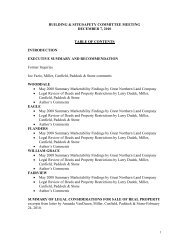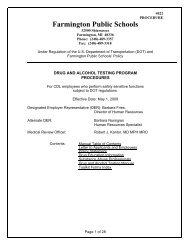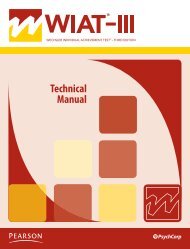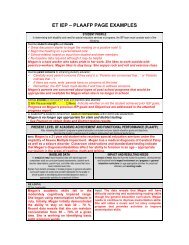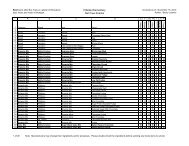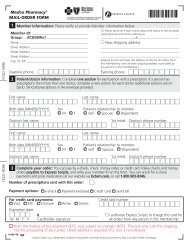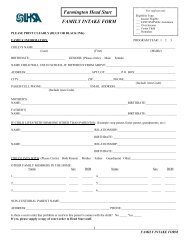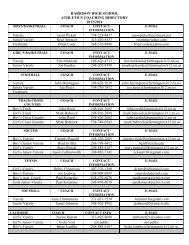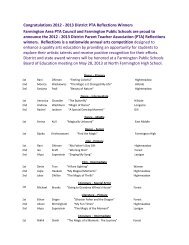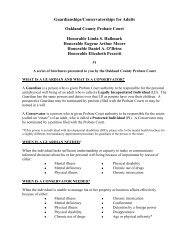Annual Report 2005-2006 - Farmington Public Schools
Annual Report 2005-2006 - Farmington Public Schools
Annual Report 2005-2006 - Farmington Public Schools
You also want an ePaper? Increase the reach of your titles
YUMPU automatically turns print PDFs into web optimized ePapers that Google loves.
District meets NCLB and Education YES!requirementsAll <strong>Farmington</strong> <strong>Public</strong><strong>Schools</strong> made AYP(Adequate YearlyProgress).16Average class sizein <strong>2005</strong>-<strong>2006</strong>Kindergarten 20Elementary, 1-5 24Middle School, 6-8 27High School, 9-12 27In <strong>2005</strong>-<strong>2006</strong>, the Districtserved the following numberof students:BuildingsElementary 13 5,096Middle School 4 2,870High School 3 3,908Alternative High 1 55Special Services * 3 223Total 12,152* includes four special educationbuildings (Cloverdale DevelopmentalTraining Center, Visions Unlimited, and WilliamE. Miller School at Boys and Girls Republic).In January 2002, the No Child Left Behind Act of 2001 (NCLB) was signed into law. This lawcontains the most sweeping changes to the Elementary and Secondary Education Act (ESEA) sinceit was enacted in 1965. It changes the federal government’s role in K-12 education by askingAmerica’s schools to describe their success in terms of what each student accomplishes. TheAct requires states to set target goals for student performance based on student achievementdata. It is intended to ensure that all children reach proficiency in reading and mathby the year 2014.NCLB requires states to establish a definition of Adequate Yearly Progress (AYP)and consequences for not making AYP. Michigan uses the state assessment, MEAP,for calculating AYP. Michigan also uses attendance rates for elementary andmiddle schools and graduation rates for high schools. NCLB requires states todevelop target starting goals for AYP and raise the bar in increments to achieve100 percent proficiency by 2014. Michigan has adopted a “step ladder”approach with incremental target goals to achieve 100 percent proficiency by2014.NCLB requires states to implement a single statewide accountabilitysystem. Michigan’s Education YES! is the statewide accountability system.Michigan’s report card includes: academic status and change along withperformance indicators integrated with AYP for a composite score/gradefor each building and district. In the fall of <strong>2005</strong>, all students in grades 3through 8 were tested in English Language Arts and Mathematics tocomply with the NCLB mandates. Science MEAP assessments arealready established at each level. NCLB requires at least 95 percent ofall students be assessed.NCLB requires calculation and reporting of student data by subgroup.Michigan calculates student information by the following subgroups:ethnicity, gender, socioeconomic, students with disabilities, and studentswith limited English proficiency.NCLB requires all teachers be highly qualified by the end of the schoolyear <strong>2005</strong>-<strong>2006</strong>. In Michigan, highly qualified means elementary certifiedteachers teaching K-5 in self-contained classrooms and middle and highschool certified teachers teaching in their major. Other options for highlyqualified include passing a rigorous state test and completing a Master’sdegree in a subject area. All teachers in the District are highly qualified.NCLB measures student achievement in reading and math. Michiganmeasures student achievement in reading and math at the elementary level; andreading, math, science and social studies at the middle and high school levels.Under Education YES! (Yardstick for Excellent <strong>Schools</strong>), schools will receivegrades of A, B, C, D-Alert, or Unaccredited. The system takes multiple measures intoaccount when grading schools. These factors include MEAP achievement data, teacherquality and professional development, continuous improvement, curriculum alignment,extended learning opportunities, arts education and humanities for all students, advancedcourse work, school facilities, family involvement, student attendance and dropout rate, andfour-year education and employment plans for high school students.In August of <strong>2006</strong>, <strong>Farmington</strong> <strong>Public</strong> <strong>Schools</strong> received the <strong>2005</strong>-<strong>2006</strong> Education Yes! <strong>Report</strong>Cards for all elementary, middle and schools. The composite Education Yes! Grades consisted of seventeenAs, two Bs, and one C with all buildings making AYP (Adequate Yearly Progress). The District also madeStudentsAdequate Yearly Progress for the <strong>2005</strong>-<strong>2006</strong> school year.<strong>Farmington</strong> <strong>Public</strong> <strong>Schools</strong> is addressing the implications of this federal legislation along with the MichiganEducation YES! Accreditation System to meet the needs of all our learners through the use of North Central AssociationCommission on Accreditation and School Improvement process.



